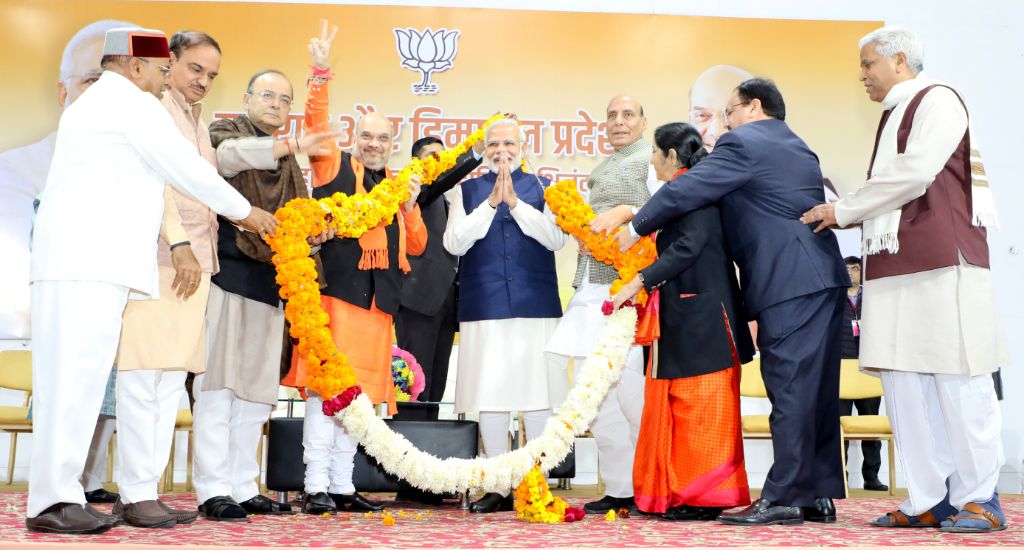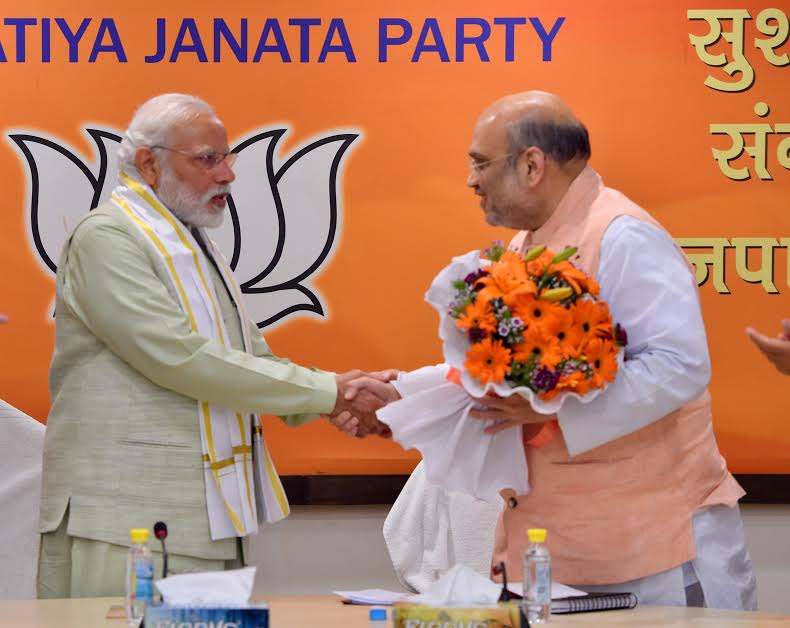
As the Bharatiya Janata Party-led National Democratic Alliance government in India completes four years in office this month, an examination of India’s socio-economic performance reveals that there is an illusion of or claimed development and progress as opposed to what can actually be empirically substantiated. Though there have been some notable positives under Modi’s watch, India today faces key challenges with respect to banking, agriculture growth, and gender equality, which, coupled with weakening democratic institutions, suggest that the Modi government has not done enough to live up to its promises.
Positives under Modi’s Governance
Though there have been some notable positives under Modi, India today faces key challenges with respect to banking, agriculture growth, and gender equality, which, coupled with weakening democratic institutions, suggest that the Modi government has not done enough to live up to its promises.
One of the key challenges that affected the ease of doing business in India, especially among small and medium scale enterprises, was a complicated indirect tax system. With the introduction of the Goods and Services Tax (GST) by the Modi government, notwithstanding its initial implementation challenges, indirect tax revenues and tax compliance mechanisms are likely to strengthen over the coming years. While the net benefits of GST in actual revenue collections may not appear till early next year and a lot needs to be done to further simplify the GST tax structure and deal with a high indirect-direct tax ratio in India’s fiscal scenario, the design and implementation of a uniform indirect tax system is a welcome move.
Another focus of the Modi government since it came to power in 2014 has been to enhance physical infrastructural capacity across states. In this realm, new public infrastructure initiatives such as the Bharatmala and Sagarmala are steps in the right direction. These programs envision laying out a well-connected network of roads, railways, waterways, and civil aviation across the country with the aim of improving people-to-people mobility as well as transport of goods.
The Modi government’s work with regard to digital communications and capacity building is also notable, with improvements in e-participation and government e-services across states.
However, despite these welcome measures, the Modi government’s policies have led to structural macroeconomic woes, have not adequately addressed the need for social reform, and weakened democratic institutions.
Structural Macroeconomic Woes
Banking and Finance
The failure of demonetization, an ad-hoc withdrawal of Rs. 500 and Rs. 1000 notes from circulation to check for black money distribution, along with its impact on aggregate money supply and the functioning of the public banking system, qualifies as one of the biggest policy flaws of the Modi government.
The failure of demonetization along with its impact on aggregate money supply and the functioning of the public banking system qualifies as one of the government’s biggest policy flaws.
India’s public banking system is currently witnessing its grimmest scenario in recent times: while ATMs remain cash strapped in the aftermath of demonetization, the high degree of non-performing assets (NPAs) and rising bank frauds are pushing most public sector banks towards a crisis of illiquidity and poor lending capacity. While the problem of NPAs has existed for a few years, it got exacerbated under Modi’s watch. For instance, according to data from the Reserve Bank of India, in 2015-2016, gross NPA as a percentage of total loans almost doubled to 7.5 percent from 3.6 percent in 2013-2014.
In resolving the crisis, the Modi government’s introduction of the Financial Resolution and Deposit Insurance Bill (FRDI) and legal amendments made to the Insolvency and Bankruptcy Code (IBC) seek to offer respite in reducing incidence of corporate loan default and the debt-ridden nature of public sector banks over the long term. However, the actual implementation of these legislations is complex and remains uncertain.
Agricultural Performance
In its manifesto for the 2014 election, the BJP had said it would give the “highest priority to agricultural growth”, promising to increase farmer incomes and ensure rural development. However, rural wages fell sharply in November 2014 and have largely not recovered since. This can be linked directly with declining farm incomes, affecting the aggregate agricultural sector growth. Farm prices of several agricultural commodities have fallen well below minimum support prices (MSPs) as agricultural distress continues to widen across most Indian states.
The declining profitability of farming as an enterprise and the average agriculture to Gross Domestic Product growth rate—down from 5.2 percent in the previous government’s tenure to 2.4 percent in the Modi years—remain significant concerns with likely repercussions on the employment scenario, food inflation levels, and food security. Unfortunately, the current Union government has not adequately addressed the issue of MSP pricing as promised, nor has it brought attention to other agriculture market reforms, including an electronic National Agriculture Market, synchronizing tariff rate policies with MSP, and facilitating easier market access for most farmers across states.

Lack of Social Policy Reform
While the recent increase in direct and indirect tax collections for the government offers enough opportunity to substantially increase public funding and investment in higher education, healthcare, and social protection, the government seems to have increased its defense spending instead.
During the 2014 election campaign, the BJP had promised to address violence against women and enact various measures for women’s welfare. However, the rising levels of crimes against women in BJP-governed states and the fact that the ruling BJP has the highest number of legislators with cases of crimes against women tell a different story. In seeking to promote women empowerment, little has been done by the Modi government beyond its nation-wide campaign of Beti Bachao Beti Padhao, which itself has lacked implementation support from civic bodies and does not have adequate monitoring mechanisms. The current administration has also been found lacking in the amount of political attention it has given to the issue of declining female labor force participation in the formal sector.
On education and healthcare, the assurances of the Modi government have rung hollow. On the contrary, one can observe a drastic decline in public funding within centrally-sponsored healthcare schemes such as the National Health Mission. There is very little known about the state of implementation of the Ayushman Bharat scheme that was recently announced in the 2018 Budget with the objective to increase healthcare insurance coverage for the poor.
In the area of higher education, the much-touted new National Education Policy is yet to be announced and debated in the parliament. Further, little has been done to improve the standard and quality of higher education and research, with the restructuring of all regulatory bodies like the University Grants Commission (UGC) into a single Higher Education Regulatory Council still awaited. While the recent increase in direct and indirect tax collections for the government offers enough opportunity to substantially increase public funding and investment in higher education, healthcare, and social protection, the government seems to have increased its defense spending instead.
Weakening Democratic Institutions
An unconditional constitutional faith in India’s democratic principles of public accountability, property rights, and civil freedom are perhaps its only competitive advantage in the current political and economic world order.
The current government, through its actions to curtail press freedom and crack down on non-profit organizations, has done little to safeguard the sanctity of democratic institutional freedom–India dropped five places in the World Press Freedom Index in 2018, going from 133 in 2016 to 138 this year. There have also been concerns recently regarding the legitimacy of the autonomous functioning of the Indian judiciary. With rising discontent against the Chief Justice of India (CJI), questioning of judicial bench allocations on critical cases, and the proposition of an impeachment motion against the CJI initiated by the opposition party, ensuring trust in the legal and public institutional order remains key to the very survival of India’s democratic roots.
An unconditional constitutional faith in India’s democratic principles of public accountability, property rights, and civil freedom are perhaps its only competitive advantage in the current political and economic world order, particularly in comparison to regimes like China, which echo more authoritarian systems of governance.
Reflecting on some of the structural, economic, and social problems under Modi, one can only hope that going into the 2019 Lok Sabha elections, the government will take due cognizance of these issues, taking proactive measures to address some of these fundamental concerns should it be re-elected.
Editor’s note: As the Narendra Modi government completes four years in office this month, SAV contributors analyze where it has succeeded and where it has floundered with respect to domestic and foreign policy. Read the entire series here.
***
Image 1: Bharatiya Janata Party website
Image 2: Bharatiya Janata Party website


